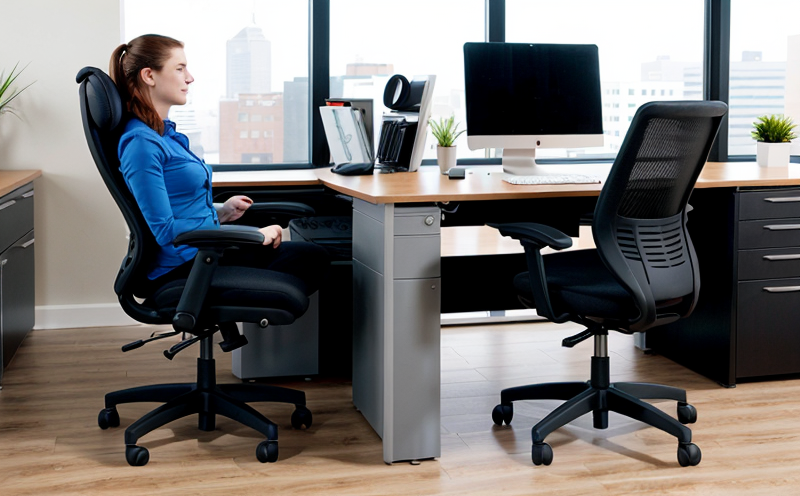ANSI HFES 100 Human Factors Ergonomic Testing of Office Workstations
The ANSI/HFES 100-2007 standard provides a framework for evaluating the human factors and ergonomic aspects of office workstations. This service is specifically designed to ensure that office furniture, including desks, chairs, and computer workstations, meets ergonomic standards which are crucial for maintaining user comfort, reducing strain, and enhancing productivity in the workplace.
The ANSI/HFES 100 standard covers several key areas critical to the design and evaluation of these workspaces. It focuses on anthropometric dimensions, visual displays, input devices such as keyboards and mice, control panels, lighting conditions, and overall workspace layout. By adhering to this standard, manufacturers can ensure their products are not only functional but also safe and user-friendly.
The testing process under ANSI HFES 100 involves several critical steps. First, the workstations are set up in a manner that simulates real-world use scenarios. This setup is crucial as it ensures that any ergonomic issues identified during testing can be directly attributed to design flaws rather than variations in user behavior or working conditions.
Anthropometric data plays a pivotal role in this process. Anthropometry involves the measurement of human body dimensions and shapes, which are used to ensure that workstation components like chairs and desks fit users properly. The standard specifies detailed anthropometric criteria for different types of workstations, taking into account gender, height range, and other relevant factors.
Visual display requirements are another significant aspect of ANSI HFES 100 testing. This includes the distance from the screen to the user's eyes, the angle at which the monitor should be positioned relative to the user’s line of sight, and the lighting conditions around the workstation. Proper visual displays prevent eye strain and enhance visibility.
Input devices are also closely scrutinized during this process. The standard provides guidelines on keyboard layout, mouse design, and other input methods to ensure they promote comfort and efficiency. Key considerations include the shape and size of buttons, key spacing, and overall ergonomics.
The overall workspace layout is another critical component of ANSI HFES 100 testing. This includes considerations such as the arrangement of furniture, lighting, and access to necessary tools and resources. Properly designed workspaces can significantly impact user comfort and productivity.
Testing methodologies under this standard are rigorous and comprehensive. They involve both static and dynamic assessments, ensuring that all aspects of ergonomic design are thoroughly evaluated. Static evaluations focus on the workstation setup in a fixed position, while dynamic tests simulate real-world movements and interactions with the furniture.
The use of advanced instrumentation is essential for accurate testing under ANSI HFES 100. This includes the use of motion capture systems to track user movements, force sensors to measure applied pressure, and other specialized equipment designed to gather precise data on ergonomic performance.
Once all tests are completed, detailed reports are generated. These reports provide a comprehensive overview of the workstation’s compliance with ANSI HFES 100 standards. They include recommendations for improvements where necessary, ensuring that manufacturers can make informed decisions about design changes based on scientific and empirical evidence.
The importance of ANSI HFES 100 testing cannot be overstated. In today's competitive market, ergonomic office furniture is not just a luxury but a necessity. By adhering to this standard, manufacturers can ensure their products meet the highest ergonomics standards, thereby enhancing user comfort and productivity while reducing the risk of strain-related injuries.
Quality and Reliability Assurance
The ANSI HFES 100 Human Factors Ergonomic Testing service is committed to delivering high-quality results that meet or exceed industry standards. Our team of experts ensures that every workstation undergoes thorough testing, using the latest in instrumentation and methodologies.
- Comprehensive anthropometric data collection
- Detailed visual display assessments
- In-depth input device evaluations
- Thorough workspace layout analysis
We employ a multi-step approach to quality control, ensuring that each workstation is tested in multiple conditions to account for real-world variations. This includes static and dynamic testing scenarios designed to replicate typical user interactions.
The use of advanced instrumentation allows us to gather precise data, which forms the basis for our detailed reports. These reports not only document compliance with ANSI HFES 100 standards but also provide actionable insights into areas where improvements can be made. Our commitment to quality and reliability is further enhanced by regular calibration and validation of all testing equipment.
Our team of experts includes certified ergonomists, human factors specialists, and experienced engineers who stay updated with the latest developments in ergonomic design and testing methodologies. This ensures that our service remains at the forefront of industry standards.
Competitive Advantage and Market Impact
- Enhanced product differentiation: ANSI HFES 100 compliance sets a benchmark for ergonomic design, differentiating products from competitors who may not adhere to such rigorous standards.
- Increased customer satisfaction: By ensuring user comfort and reducing strain, compliant products lead to higher customer satisfaction levels.
- Improved brand reputation: Compliance with industry-leading standards like ANSI HFES 100 enhances a company’s reputation as a leader in quality and reliability.
The impact of ANSI HFES 100 compliance extends beyond just the product itself. It also influences how manufacturers approach design, leading to innovations that continuously improve ergonomic performance. This can translate into a competitive edge in the market, attracting more discerning customers who value ergonomics and comfort.
Use Cases and Application Examples
The ANSI HFES 100 Human Factors Ergonomic Testing service finds application in various industries where office furniture plays a significant role. This includes corporate offices, educational institutions, healthcare facilities, and government organizations. By ensuring that all workstations meet ergonomic standards, these institutions can enhance the overall working environment, leading to increased productivity and satisfaction.
Incorporating ANSI HFES 100 into product development processes ensures early identification of potential ergonomic issues. This allows for timely design adjustments, reducing costs associated with post-production fixes. Additionally, compliance with this standard is often a prerequisite for certification and regulatory approval, making it an essential component of any comprehensive quality assurance program.





